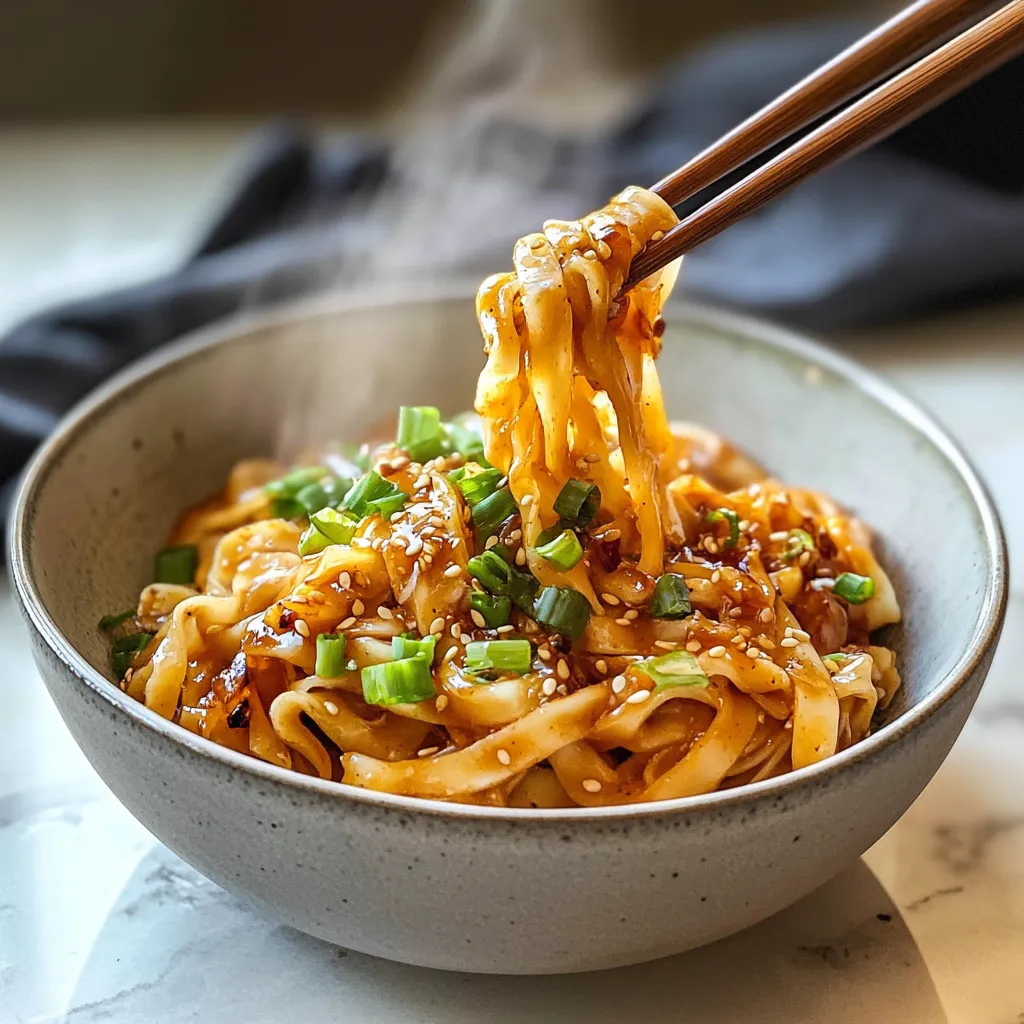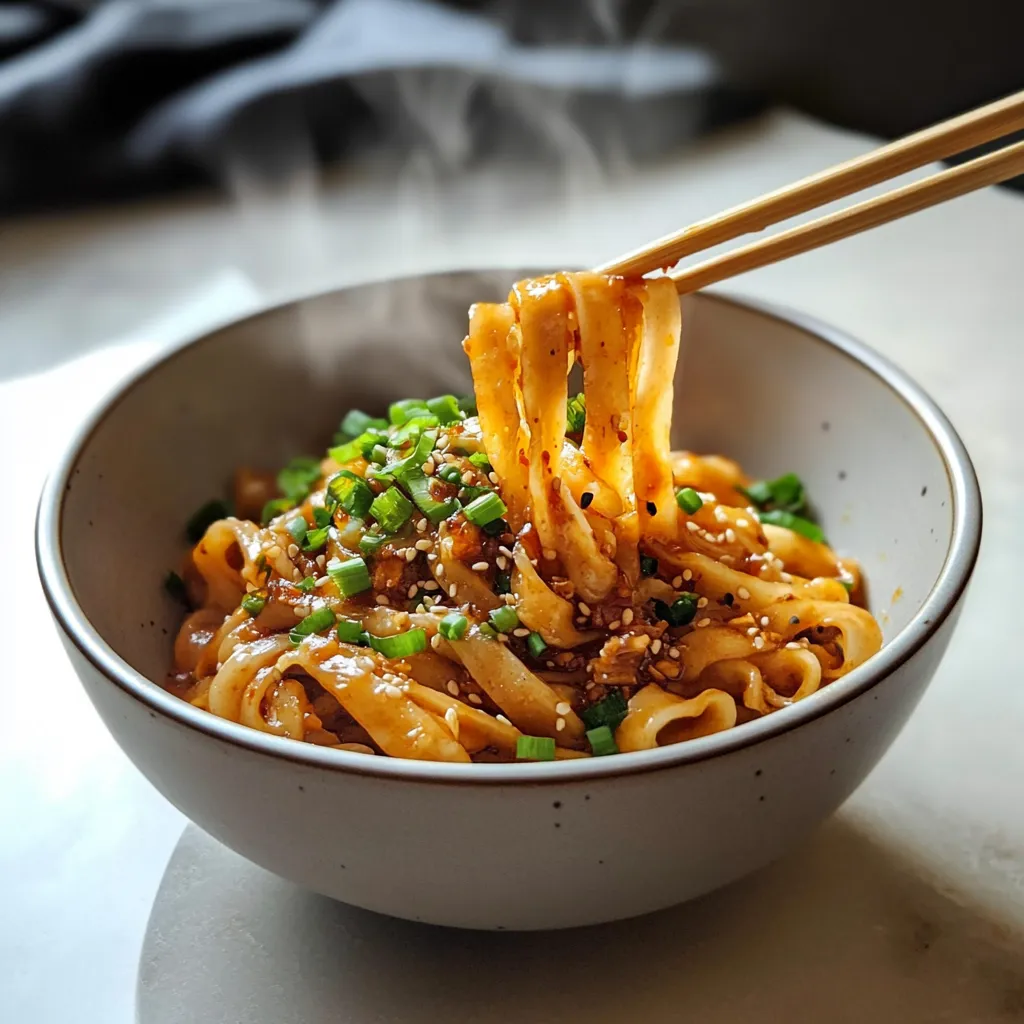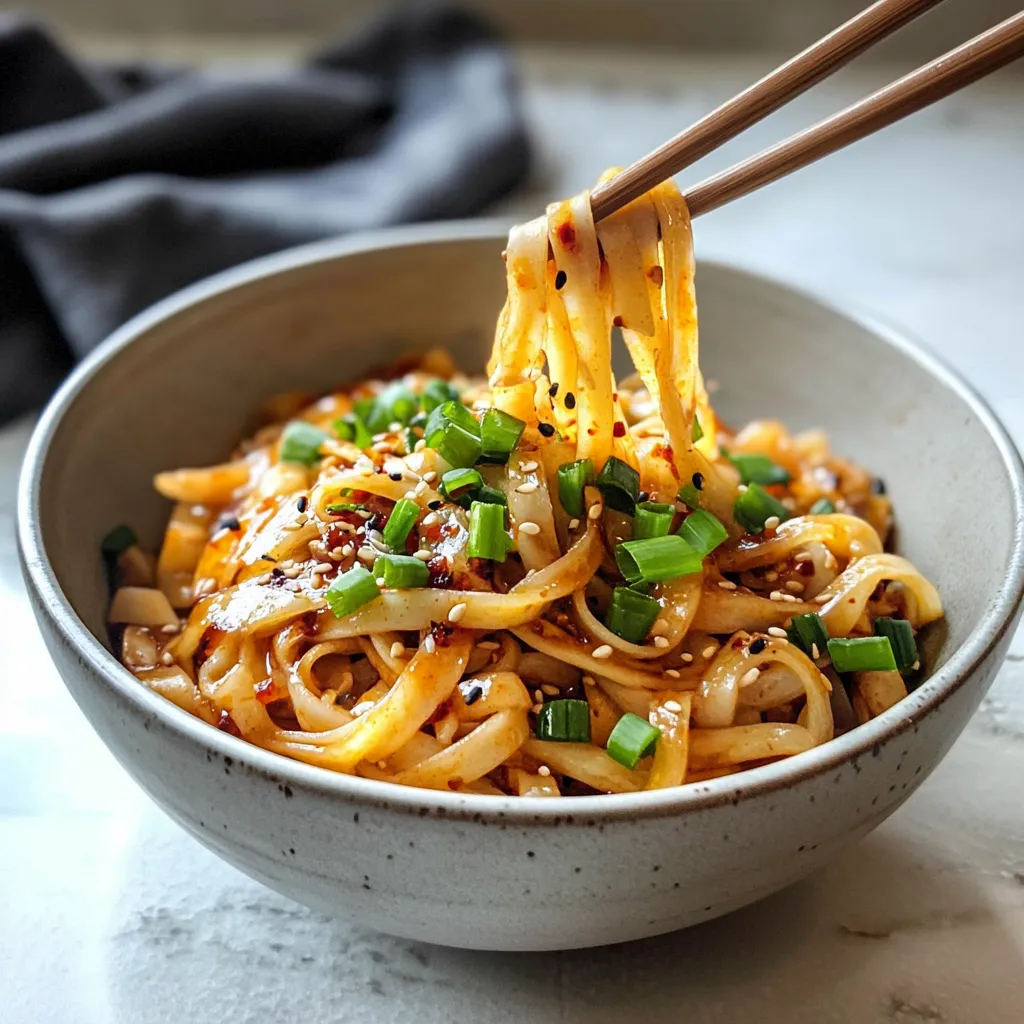 Pin it
Pin it
These Szechuan noodles transform ordinary pantry ingredients into an extraordinary flavor experience in just 30 minutes. Tender noodles bathe in a complex sauce that balances spicy, savory, sweet, and tangy notes to create that distinctive Szechuan character. The dish achieves remarkable depth without requiring special cooking techniques or hard-to-find ingredients. Perfect for hectic weeknights when you crave something exciting but have limited time and energy, these noodles deliver authentic taste without the usual restaurant wait time or expense.
I discovered this recipe during a particularly busy period when takeout was becoming too frequent. Determined to create something that rivaled our favorite Szechuan restaurant but fit into a weeknight schedule, I began experimenting with pantry staples. The first time I served these noodles, my husband stopped mid-bite and asked if I'd secretly ordered from our usual place. The children, typically suspicious of anything with visible seasonings, requested seconds before finishing their first serving. Now this dish appears on our table at least twice monthly, each time with slight variations based on whatever vegetables need using.
Flavor Foundation
- Noodles: Provide the hearty foundation that absorbs the complex sauce. Medium-thickness wheat noodles work best, offering sufficient surface area for sauce adhesion while maintaining satisfying chewiness. Fresh noodles deliver superior texture but dried varieties work perfectly well for convenience.
- Fresh Ginger: Contributes essential aromatic heat that defines authentic Szechuan cooking. Unlike dried versions, fresh ginger offers bright, zesty notes with subtle citrus undertones. Select firm pieces without wrinkles or soft spots for optimal flavor impact.
- Garlic: Delivers aromatic depth that penetrates the entire dish. Fresh cloves provide significantly more dimension than pre-minced options. Mince finely for even distribution throughout the sauce, allowing flavors to fully incorporate.
- Green Onions: Add freshness and mild allium notes that brighten the rich sauce. The white parts provide savory foundation when cooked, while the green sections offer fresh contrast when sprinkled on top. Both sections contribute essential flavor components.
- Soy Sauce: Creates the umami foundation essential for authentic Asian flavors. Regular soy sauce provides sufficient saltiness, though low-sodium varieties allow for better flavor control. Dark soy sauce offers deeper color and slightly more complex flavor if available.
- Rice Vinegar: Introduces crucial acidity that balances richness and awakens other flavors. Its subtle sweetness differentiates it from harsher vinegars. Unseasoned varieties work best for this recipe, allowing you to control sweetness separately.
- Szechuan Chili Paste: Delivers the signature numbing heat characteristic of the region's cuisine. Authentic pastes contain both chili and Szechuan peppercorns for that distinctive tingling sensation. Adjust quantity based on heat preference without compromising overall flavor profile.
- Hoisin Sauce: Provides sweet complexity with subtle five-spice undertones. This thick sauce adds body to the noodle coating while contributing fermented depth. Its balance of sweet, salty, and umami elements ties the sauce together beautifully.
Cooking Process
- Noodle Preparation:
- Bring a large pot of water to a rolling boil before adding noodles. Stirring immediately prevents sticking, while maintaining the boil ensures proper cooking. Test frequently for ideal doneness—the noodles should retain slight resistance when bitten. Drain immediately and rinse briefly under cold water to stop cooking and remove excess starch that would cause clumping. This precise cooking creates the perfect texture foundation.
- Sauce Development:
- Combine soy sauce, rice vinegar, Szechuan chili paste, hoisin sauce, sugar, and broth in a bowl, whisking thoroughly to integrate ingredients completely. This pre-mixing ensures even distribution throughout the dish without needing excessive cooking time. Allow sauce to sit briefly while preparing other components, which permits flavors to begin melding even before heat application.
- Aromatic Activation:
- Heat vegetable oil in a wok or large frying pan until it shimmers but doesn't smoke. Add minced ginger and garlic, stirring constantly to prevent burning while releasing essential oils. This brief, high-heat contact transforms the raw, harsh flavors into fragrant complexity. The aromatic sizzle serves as an indicator that flavors are properly developing.
- Integration Technique:
- Add pre-cooked noodles to the aromatic oil, tossing quickly to coat with the fragrant base. Pour prepared sauce around the perimeter of the pan rather than directly on the noodles, allowing it to heat evenly before incorporation. Using tongs or chopsticks, lift and turn noodles repeatedly to ensure even sauce distribution and proper heating without mushiness.
- Final Balance:
- Remove from heat once noodles are thoroughly coated and sauce has slightly thickened from evaporation. Toss with most of the green onions, reserving some for garnish. This off-heat finishing prevents overcooking while allowing raw ingredients to mellow slightly from residual heat, creating perfect final texture and flavor balance.
 Pin it
Pin it
My grandmother always emphasized the importance of preparing all ingredients before heating the wok, calling it "setting your stage." During my first attempt at this recipe, I ignored her advice and frantically chopped while trying to prevent garlic from burning. The resulting unevenly cooked dish taught me the wisdom in her methods. Now my children help arrange the mise en place, learning cooking fundamentals while creating our family's version of this classic dish. My youngest takes particular pride in whisking the sauce, carefully counting stirs to ensure proper mixing.
Presentation Options
Transform these versatile noodles into varied dining experiences based on your preferences and needs. For a complete meal, top with sesame-crusted seared tofu or tender sliced beef marinated in the same flavor profile. The protein absorbs the sauce beautifully while adding satisfying substance. Create a noodle bowl experience by arranging over quickly blanched baby bok choy and adding a soft-boiled egg, allowing the creamy yolk to enrich the sauce when broken. For casual entertaining, serve smaller portions in decorative Chinese soup spoons as an impressive passed appetizer. Consider offering alongside simple steamed vegetables dressed only with sesame oil for a satisfying meal that balances bold and subtle flavors.
Creative Adaptations
Customize this adaptable recipe to create exciting variations while maintaining authentic flavor foundations. For extra nutrition and color, add julienned red bell peppers and snow peas during the final minute of cooking. They maintain pleasant crispness while absorbing sauce flavors. Seafood enthusiasts might incorporate quickly sautéed shrimp or scallops for elegant protein addition. Those seeking heartier texture can substitute half the noodles with spiralized vegetables like zucchini or carrots. For special occasions, consider lobster or crab meat folded in after cooking for luxurious enhancement that complements the sauce beautifully.
Storage Wisdom
Maximize convenience by understanding proper storage and reheating techniques. Store cooled leftover noodles in airtight glass containers in the refrigerator for up to two days. The flavors actually develop overnight, often tasting even better the second day. When reheating, add a tablespoon of water or broth before covering and microwaving at 70% power, stirring halfway through. This gentle reheating prevents the noodles from becoming tough or dry. Alternatively, briefly reheat in a wok with a splash of water, tossing constantly for fresher texture. Consider making a double batch specifically for planned leftovers, as the dish reheats beautifully for quick lunches.
I've prepared these Szechuan noodles countless times, tweaking and perfecting the recipe with each iteration. What continues to impress me is how such simple pantry ingredients transform into something that genuinely satisfies our cravings for restaurant-quality Asian cuisine. The versatility allows me to adapt to whatever ingredients need using, from languishing vegetables to leftover proteins. Friends have requested the recipe after tastings, often expressing surprise at the simplicity once they learn the method. Whether served as a quick family dinner or dressed up for entertaining, these noodles deliver the perfect balance of convenience and complex flavor that makes home cooking truly rewarding.
 Pin it
Pin it
Frequently Asked Questions
- → How spicy are these Szechuan noodles?
- With 2 tablespoons of Szechuan chili paste, these noodles have a moderate spice level. For a milder version, start with just 1 teaspoon and add more to taste. For extra heat, add a teaspoon of chili oil as well.
- → What can I substitute for Szechuan chili paste?
- If you can't find Szechuan chili paste, you can use sambal oelek, sriracha (though it's sweeter), or Korean gochujang (which adds some sweetness). Even a mix of red pepper flakes and a bit of sesame oil can work in a pinch.
- → What protein would go well with these noodles?
- Traditional Dan Dan noodles often include ground pork, but you can add cooked chicken, shrimp, tofu, or tempeh. Simply cook your protein separately and add it when combining the noodles with the sauce.
- → Can I make this dish gluten-free?
- Yes, use rice noodles or other gluten-free noodles, and make sure to use gluten-free soy sauce (tamari) and hoisin sauce. Check your chili paste ingredients as well, as some may contain wheat.
- → What vegetables can I add to these noodles?
- Besides snow peas, good additions include thinly sliced bell peppers, broccoli florets, baby bok choy, mushrooms, carrots, or bean sprouts. Just add firmer vegetables earlier in the cooking process.
- → Can I make the sauce ahead of time?
- Absolutely! The sauce can be prepared up to 3 days ahead and stored in the refrigerator. This is a great way to make weeknight cooking even faster - just cook the noodles and vegetables, then add your premade sauce.
